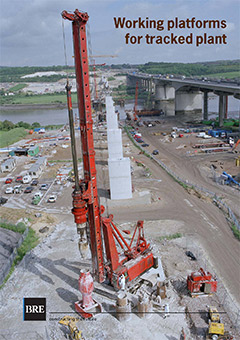Working platforms for tracked plant: good practice guide to the design, installation, maintenance and repair of ground-supported working platforms
BRE (Building Research Establishment) is an independent, research-based consultancy, testing and training organisation, operating in the built environment and associated industries.
On 1 June 2004, BRE published Working platforms for tracked plant: good practice guide to the design, installation, maintenance and repair of ground-supported working platforms (BR 470), written by Hilary Skinner.
For the purposes of this publication, the expression ‘working platform’ is restricted to ground-supported working platforms for tracked plant, constructed of granular material, including not only itself, but also the associated ramps and access.
Ground-supported working platforms are critical for plant stability. Safety is a vital issue, and most perform well, but rigs overturn more frequently than they should. The Federation of Piling Specialists instigated the preparation of this guide to help improve practices related to the use of piling and associated specialist plant and to promote safety in design, specification, installation, operation, maintenance and repair of working platforms without unnecessary or excessive expenditure.
The 52-page guide highlights important issues in site assessment, design, installation and maintenance of working platforms. Design calculations are given, together with worked examples for different subgrade properties.
The contents are:
- Foreword.
- Site conditions.
- Design.
- Installation.
- Operation, maintenance and repair.
- Photographs.
- Appendix A: Design calculations.
- Appendix B: Determination of characteristic values of soil and geosynthetic parameters.
- Notation and abbreviations.
- References.
[edit] Related articles on Designing Buildings Wiki
- BRE articles on Designing Buildings Wiki
- Building Research Establishment.
- Construction plant.
- Lift table.
- Lifting device.
- Lifting platform.
- Piling mat.
- Scaffolding.
- Scissor lift.
- Types of crane.
- Work at height.
- Working at height - our duty to prevent harm and protect each other.
- Work at height regulations.
- Working platform.
Featured articles and news
Impact report from the Supply Chain Sustainability School
Free sustainability skills, training and support delivered to thousands of UK companies to help cut carbon.
The Building Safety Forum at the Installershow 2025
With speakers confirmed for 24 June as part of Building Safety Week.
The UK’s largest air pollution campaign.
Future Homes Standard, now includes solar, but what else?
Will the new standard, due to in the Autumn, go far enough in terms of performance ?
BSRIA Briefing: Cleaner Air, Better tomorrow
A look back at issues relating to inside and outside air quality, discussed during the BSRIA briefing in 2023.
Restoring Abbotsford's hothouse
Bringing the writer Walter Scott's garden to life.
Reflections on the spending review with CIAT.
Retired firefighter cycles world to raise Grenfell funds
Leaving on 14 June 2025 Stephen will raise money for youth and schools through the Grenfell Foundation.
Key points for construction at a glance with industry reactions.
Functionality, visibility and sustainability
The simpler approach to specification.
Architects, architecture, buildings, and inspiration in film
The close ties between makers and the movies, with our long list of suggested viewing.
SELECT three-point plan for action issued to MSPs
Call for Scottish regulation, green skills and recognition of electrotechnical industry as part of a manifesto for Scottish Parliamentary elections.
UCEM becomes the University of the Built Environment
Major milestone in its 106-year history, follows recent merger with London School of Architecture (LSE).
Professional practical experience for Architects in training
The long process to transform the nature of education and professional practical experience in the Architecture profession following recent reports.
A people-first approach to retrofit
Moving away from the destructive paradigm of fabric-first.
International Electrician Day, 10 June 2025
Celebrating the role of electrical engineers from André-Marie Amperè, today and for the future.
New guide for clients launched at Houses of Parliament
'There has never been a more important time for clients to step up and ...ask the right questions'
The impact of recycled slate tiles
Innovation across the decades.
EPC changes for existing buildings
Changes and their context as the new RdSAP methodology comes into use from 15 June.




























Comments